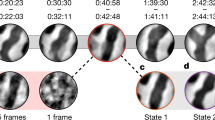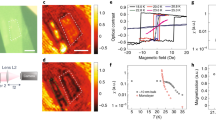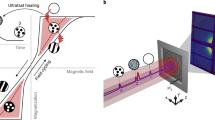Abstract
A quantum phase transition (QPT) occurs between two competing phases of matter at zero temperature, driven by quantum fluctuations. Although the presence of these fluctuations is well established, they have not been locally imaged in space, and their local dynamics has not been studied so far. We use a scanning superconducting quantum interference device to image quantum fluctuations near the QPT from a superconductor to an insulator. We find fluctuations of the diamagnetic response in both space and time that survive well below the transition temperature, demonstrating their quantum nature. The fluctuations appear as telegraph-like noise with a range of characteristic times and a non-monotonic temperature dependence, revealing unexpected quantum granularity. The lateral dimension of these fluctuations grows towards criticality, offering a new measurable length scale. Our results provide physical insight into the reorganization of phases across a QPT, with implications for any theoretical description. This paves a new route for future quantum information applications.
This is a preview of subscription content, access via your institution
Access options
Access Nature and 54 other Nature Portfolio journals
Get Nature+, our best-value online-access subscription
$29.99 / 30 days
cancel any time
Subscribe to this journal
Receive 12 print issues and online access
$209.00 per year
only $17.42 per issue
Buy this article
- Purchase on Springer Link
- Instant access to full article PDF
Prices may be subject to local taxes which are calculated during checkout





Similar content being viewed by others
References
Rubiño-Martín, J. A., Rebolo, R. & Mediavilla, E. The Cosmic Microwave Background: From Quantum Fluctuations to the Present Universe: XIX Canary Islands Winter School on Astrophysics (Cambridge Univ. Press, Cambridge, 2010).
Sachdev, S. Quantum Phase Transitions (Cambridge Univ. Press, Cambridge, 2011).
Löhneysen, Hv, Rosch, A., Vojta, M. & Wölfle, P. Fermi-liquid instabilities at magnetic quantum phase transitions. Rev. Mod. Phys. 79, 1015–1075 (2007).
Endres, M. et al. The ‘Higgs’ amplitude mode at the two-dimensional superfluid/Mott insulator transition. Nature 487, 454–458 (2012).
Rançon, A. & Dupuis, N. Quantum XY criticality in a two-dimensional Bose gas near the Mott transition. Europhys. Lett. 104, 16002 (2013).
Paalanen, M. A., Hebard, A. F. & Ruel, R. R. Low-temperature insulating phases of uniformly disordered two-dimensional superconductors. Phys. Rev. Lett. 69, 1604–1607 (1992).
Yazdani, A. & Kapitulnik, A. Superconducting–insulating transition in two-dimensional a-MoGe thin films. Phys. Rev. Lett. 74, 3037–3040 (1995).
Markovic, N., Christiansen, C. & Goldman, A. M. Thickness–magnetic field phase diagram at the superconductor–insulator transition in 2D. Phys. Rev. Lett. 81, 5217–5220 (1998).
Baturina, T. I., Strunk, C., Baklanov, M. R. & Satta, A. Quantum metallicity on the high-field side of the superconductor–insulator transition. Phys. Rev. Lett. 98, 127003 (2007).
Crane, R. W. et al. Fluctuations, dissipation, and nonuniversal superfluid jumps in two-dimensional superconductors. Phys. Rev. Lett. B 75, 094506 (2007).
Strack, P. & Jakubezyk, P. Fluctuations of imbalanced fermionic superfluids in two dimensions induce continuous quantum phase transitions and non-Fermi-liquid behavior. Phys. Rev X 4, 021012 (2014).
Shi, X., Lin, P. V., Sasagawa, T., Dobrosavljević, V., & Popović, D. Two-stage magnetic-field-tuned superconductor–insulator transition in underdoped La2–xSrxCuO4.Nat. Phys. 10, 437–443 (2014).
Sherman, D. et al. The Higgs mode in disordered superconductors close to a quantum phase transition. Nat. Phys. 11, 188–192 (2015).
Poran, S. et al. Quantum criticality at the superconductor–insulator transition revealed by specific heat measurements. Nat. Comm. 8, 14464 (2017).
Ghosal, A., Randeria, M. & Trivedi, N. Role of spatial amplitude fluctuations in highly disordered s-wave superconductors. Phys. Rev. Lett. 81, 3940–3943 (1998).
Ghosal, A., Randeria, M. & Trivedi, N. Inhomogeneous pairing in highly disordered s-wave superconductors. Phys. Rev. B 65, 014501 (2001).
Bouadim, K., Loh, Y. L. M., Randeria, M. & Trivedi, N. Single and two-particle energy gaps across the disorder-driven superconductor–insulator transition. Nat. Phys. 7, 884–889 (2011).
Kowal, D. & Ovadyahu, Z. Scale dependent superconductor-insulator transition. Physica C 468, 322–325 (2008).
Sacepe, B. et al. Disorder-Induced inhomogeneities of the superconducting state close to the superconductor–insulator transition. Phys. Rev. Lett. 101, 157006 (2008).
Sacepe, B. et al. Localization of preformed Cooper pairs in disordered superconductors. Nat. Phys. 7, 239–244 (2011).
Mondal, M. et al. Phase fluctuations in a strongly disordered s-wave NbN superconductor close to the metal–insulator transition. Phys. Rev. Lett. 106, 047001 (2011).
Ganguly, R. et al. Magnetic field induced emergent inhomogeneity in a superconducting film with weak and homogeneous disorder. Phys. Rev. B 96, 054509 (2017).
Carbillet, C. et al. Confinement of superconducting fluctuations due to emergent electronic inhomogeneities. Phys. Rev. B 93, 144509 (2016).
Kirtley, J. R. Fundamental studies of superconductors using scanning magnetic imaging. Rep. Prog. Phys. 73, 126501 (2010).
Wissberg, S., Frydman, A. & Kalisky, B. Local view of superconducting fluctuations. Appl. Phys. Lett. 112, 262602 (2018).
Goldman, A. M. & Markovic, N. Superconductor-insulator transitions in the two-dimensional limit. Phys. Today 51, 39–41 (November,1998).
Lim, B. S., Rahtu, A. & Gordon, R. G. Atomic layer deposition of transition metals. Nat. Mater. 2, 749–754 (2003).
Shiino, T. et al. Improvement of the critical temperature of superconducting NbTiN and NbN thin films using the AlN buffer layer. Supercond. Sci. Technol. 23, 045004 (2010).
Burdastyh, M. V. et al. Superconductor–insulator transition in NbTiN films. JETP Lett. 106, 749–753 (2017).
Gardner, B. W. et al. Scanning superconducting quantum interference device susceptometry. Rev. Sci. Instrum. 72, 2361–2364 (2001).
Huber, M. E. et al. Gradiometric micro-SQUID susceptometer for scanning measurements of mesoscopic samples. Rev. Sci. Instrum. 79, 053704 (2008).
Trivedi, N., Scalettar, R. T. & Randeria., M. Superconductor–insulator transition in a disordered electronic system. Phys. Rev. B 54, R3756(R) (1996).
Wallin, M., Sorensen, E. S., Girvin, S. M. & Young, A. P. Superconductor–insulator transition in two-dimensional dirty boson systems. Phys. Rev. B 49, 12115–12139 (1994).
Swanson, M., Loh, Y. L., Randeria, M. & Trivedi, T. Dynamical conductivity across the disorder-tuned superconductor–insulator transition. Phys. Rev. X 4, 021007 (2014).
Acknowledgements
We are grateful for technical help from I. Volotchenko and E. A. Persky, and for discussions with D. Roditchev. A.K. and B.K. were supported by the European Research Council grant ERC-2014-STG-639792 and the Israel Science Foundation grant ISF-1281/17. A.F. and N.T. acknowledge support from the Israel US bi-national foundation grant no. 2014325. A.K., A.F and B.K acknowledge the COST Action CA16218. B.K. acknowledges the QuantERA ERA-NET Cofund in Quantum Technologies (project no. 731473). T.I.B. acknowledges support by the Russian Science Foundation (project no. 14-22-00143) and by the Consejería de Educación, Cultura y Deporte (Comunidad de Madrid) through the talent attraction programme, ref. 2016-T3/IND-1839.
Author information
Authors and Affiliations
Contributions
A.K. and B.K. designed the experiment and performed the measurements. A.F. initiated the research and participated in experiments. T.I.B. provided the samples and related measurements. H.K., Y.L.L. and N.T. performed the calculations. N.T, A.F. and B.K. prepared the manuscript with input from all co-authors.
Corresponding authors
Ethics declarations
Competing interests
The authors declare no competing interests.
Additional information
Publisher’s note: Springer Nature remains neutral with regard to jurisdictional claims in published maps and institutional affiliations.
Supplementary information
Supplementary Information
Supplementary Figures 1–6
Supplementary Video
Evolution of susceptibility in sample S1 with temperature. Top panel: susceptibility maps at different temperatures in S1. The images, STD and susceptibility signal describe the local evolution of susceptibility as the sample heats slightly above Tc and cooled down again. At T > Tc no diamagnetic response is observed and the image reflects the SQUID noise. At T < Tc the image shows the presence of darker puddles and streaks of weaker superconductivity, which survive well below Tc. Bottom panel, left: standard deviation (STD) versus temperature, extracted from susceptibility maps shown in the top panel. The STD is normalized to the highest value in each curve. Bottom panel, right: susceptibility signal versus temperature. The vertical bars show the range of susceptibility values in each image.
Rights and permissions
About this article
Cite this article
Kremen, A., Khan, H., Loh, Y.L. et al. Imaging quantum fluctuations near criticality. Nature Phys 14, 1205–1210 (2018). https://doi.org/10.1038/s41567-018-0264-z
Received:
Accepted:
Published:
Issue Date:
DOI: https://doi.org/10.1038/s41567-018-0264-z
This article is cited by
-
Fundamental quantum limits of magnetic nearfield measurements
npj Quantum Information (2023)



